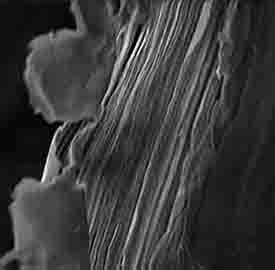Northwestern Engineering professor Jiaxing Huang has developed a cheaper, more stable proton-conducting system. To find the key ingredient, he had to look no further than his own backyard.
“We used a clay that you can buy at a gardening store,” said Huang, associate professor of materials science and engineering at Northwestern’s McCormick School of Engineering. “I like to call it a ‘down-to-earth’ material.”
When a proton is transported, it generates an electrical current that plays a key role in both nature and technology. Engineers are particularly interested in harnessing proton conduction for catalysis, electrochemical sensors and reactors, and harvesting energy. In fuel cells, for example, a proton must be transported across a membrane in order to reach a cathode, completing the conversion of chemical energy into electricity.
In cells, protons can be transported through nanopores formed by membrane proteins. Engineers have been trying to mimic this by creating artificial proton nanochannels. For the past 20 years, they have used nanolithography to create nanochannels in silicon, glass, and other materials to enhance ionic transport and conductivity. Those nanochannels do result in higher conductivity, but there are two major problems: nanolithography is complex and expensive, and the final material is difficult to produce on a large scale.
“Many types of nanochannels have been demonstrated on a substrate,” Huang said. “But it has been difficult to produce them in large quantities, say, a substrate filled with nanochannels.”
Huang’s new solution capitalizes on clay’s natural properties. When two-dimensional sheets of the clay, called vermiculite, are exfoliated in water, they carry negative charges, attracting positively charged protons. After the sheets dry, they self-assemble into paper-like films. The near 1-nanometer spacing between the layers serves as the nanochannels that can concentrate protons for conduction.
Supported by the Office of Naval Research and Northwestern’s Materials Research Science and Engineering Center, Huang’s research is described in a paper published on the July 13 in Nature Communications. Other authors of the paper include former visiting student Jiao-Jing Shao, former postdoctoral scholar Kalyan Raidongia, and graduate student Andrew Koltonow. Shao and Raidongia have completed their training at Northwestern and are now professors in China and India, respectively.
Compared to graphene-based sheets and other two-dimensional materials, clay layers have significant advantages for constructing ion conducting devices and materials. Clay is readily available and can be exfoliated in water by ionic exchange, which is much more benign than the chemical exfoliation needed for graphene and other materials. It also has extraordinary chemical and thermal stability, capable of withstanding temperatures higher than 500 degrees Celsius.
“Clay has extraordinary thermal stability,” Huang said. “We want to create a proton conducting system that can sustain very high temperatures because some of the best proton-conducting materials out there can’t do that.”
The simplicity of the material processing techniques required to produce such 2-D nanochannels makes it easy to scale up. Therefore, instead of resulting in a small number of channels, over 30 percent of the volume of Huang’s clay membrane is made of proton-conducting nanochannels.
Huang calls his clay membrane a new example of “bulk nanostructured materials,” which refers to a macroscopic form of materials with structural units at nanometer scale. Bulk nanostructure materials are of great interest, partially because they have new properties that are untenable to their nanostructured units.
In this case, the individual clay sheets do not have proton-conducting properties. They need to assemble face-to-face to generate the final bulk form of material, in which all of the sheets collectively support the proton-conducting properties.
“We’re studying nanomaterials beyond the individual nanostructured unit,” he said. “This is a bulk material that can be readily seen, manipulated, and used.”
If our reporting has informed or inspired you, please consider making a donation. Every contribution, no matter the size, empowers us to continue delivering accurate, engaging, and trustworthy science and medical news. Independent journalism requires time, effort, and resources—your support ensures we can keep uncovering the stories that matter most to you.
Join us in making knowledge accessible and impactful. Thank you for standing with us!

